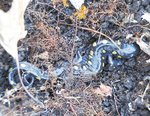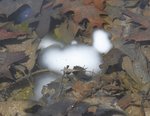 Narrowsburg
NarrowsburgLight Rain Fog/Mist, 43°
Wind: 8.1 mph
 Narrowsburg
NarrowsburgIf you have walked past a small pond within the last few days, chances are you have heard the first wood frogs quacking away as they strive to attract a mate and breed. Soon after, spring peepers …
Stay informed about your community and support local independent journalism.
Subscribe to The River Reporter today. click here
This item is available in full to subscribers.
Please log in to continue |


If you have walked past a small pond within the last few days, chances are you have heard the first wood frogs quacking away as they strive to attract a mate and breed. Soon after, spring peepers will start their breeding call. Once again, the pond will become a very noisy place indeed.
There are a few amphibians, however, that do not make any noise at all. They make their way to the pond, lay their eggs and seemingly disappear until next spring. They don’t call or make noise. They are common in the region but not commonly seen. When they move to the vernal ponds, it is during the cover of darkness: Welcome to the domain of the spotted salamander.
Spotted salamanders are a member of the mole salamander family. They spend most of their time under rocks and logs. In addition, this salamander utilizes burrows either made by itself or other animals to escape predators if it’s hiding rock gets overturned. Spotted salamanders are fairly large and chunky with yellow spots on each side of its vertebral ridge on its dorsal side. It has 12 costal grooves that are visible when viewed from the side. Like wood frogs and spring peepers, this salamander utilizes vernal ponds to lay its eggs.
Along with the two frog species mentioned, spotted salamanders start breeding very early. The hatched offspring only have a few months before many ponds dry up. Before that time comes, the larval salamanders develop lungs and become air-breathing amphibians. The adult spotted salamander seeks out her natal pond to lay eggs, perhaps skipping over perfectly good ponds on her trek.
Now is the time to spot salamanders at night crossing roads near bodies of water. If driving on the roads, be careful of crossing amphibians near such wetland areas. Late in March to early April, look for the whitish egg masses of spotted salamanders in shallow vernal ponds. A possible viewing opportunity exists at the Delaware Water Gap Recreational Area on River Road near NPS headquarters. Check the site for updates (along with any COVID-19-related alerts).
Comments
No comments on this item Please log in to comment by clicking here